Abstract
1. The motility of the reticulo-rumen and omasum in conscious sheep was studied by electromyography from chronically implanted nichrome wire electrodes. The sheep were subjected to vagotomy and were maintained totally by intragastric infusion of liquid nutrients before and after vagotomy. Before vagotomy the motility of the forestomach was essentially similar to that seen in roughage-fed sheep.
2. Bilateral thoracic vagotomy transiently abolished all electrical activity of the reticulo-rumen and omasum, but within 1 day some activity returned. Frequent periods of rhythmic local small group discharges were seen over the reticulo-rumen, while the omasum showed prolonged (1-5 min) bursts of mainly slow wave activity.
3. Within 1-2 weeks of vagotomy strong contractions of the reticulo-rumen were visible by radiography. Electromyographically, they comprised a rhythmic series of some two to five large group discharges recurring approximately once a minute. Each series of activity was separated from the next by a short period of quiescence. The discharges occurred almost simultaneously over the whole reticulo-rumen and so contrasted with the progressive forward or backward spread of activity seen in the intact animal. The bursts of activity in the omasum, lasting 0·5-2 min, were not co-ordinated with the activity of the reticulo-rumen as they are in the intact animal.
4. The activity in the reticulo-rumen and omasum was not affected by bilateral section of the splanchnic nerves and removal of the coeliaco-mesenteric ganglia. Reticulo-rumen but not omasal activity was abolished by atropine (0·1 mg/kg) or hexamethonium (2 mg/kg), while both were stimulated by pentagastrin (3 μg/kg).
5. Following vagotomy reticulo-rumen motility was no longer influenced by feeding, or by tactile stimulation of the buccal cavity or oesophagus. Severe distension of the abomasum caused a slight acceleration of the motility rhythm compared to the inhibition seen before vagotomy.
6. It is concluded that the reticulo-rumen motility observed after vagotomy is an intrinsic cholinergic motility which is dependent upon the activity of the myenteric plexus. The motility of the omasum after vagotomy is similar to that seen in the intact animal and differs from that of the rumen in that it appears not to depend wholly upon cholinergic control.
Full text
PDF




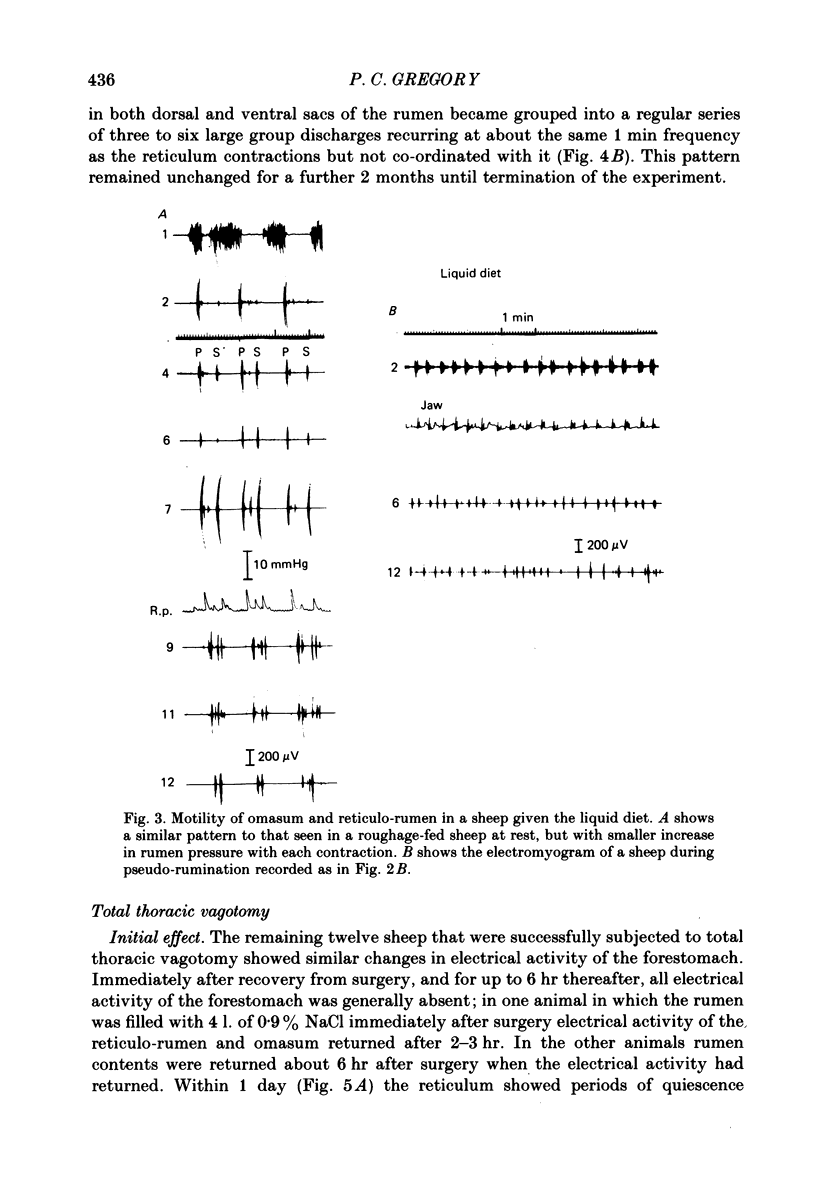
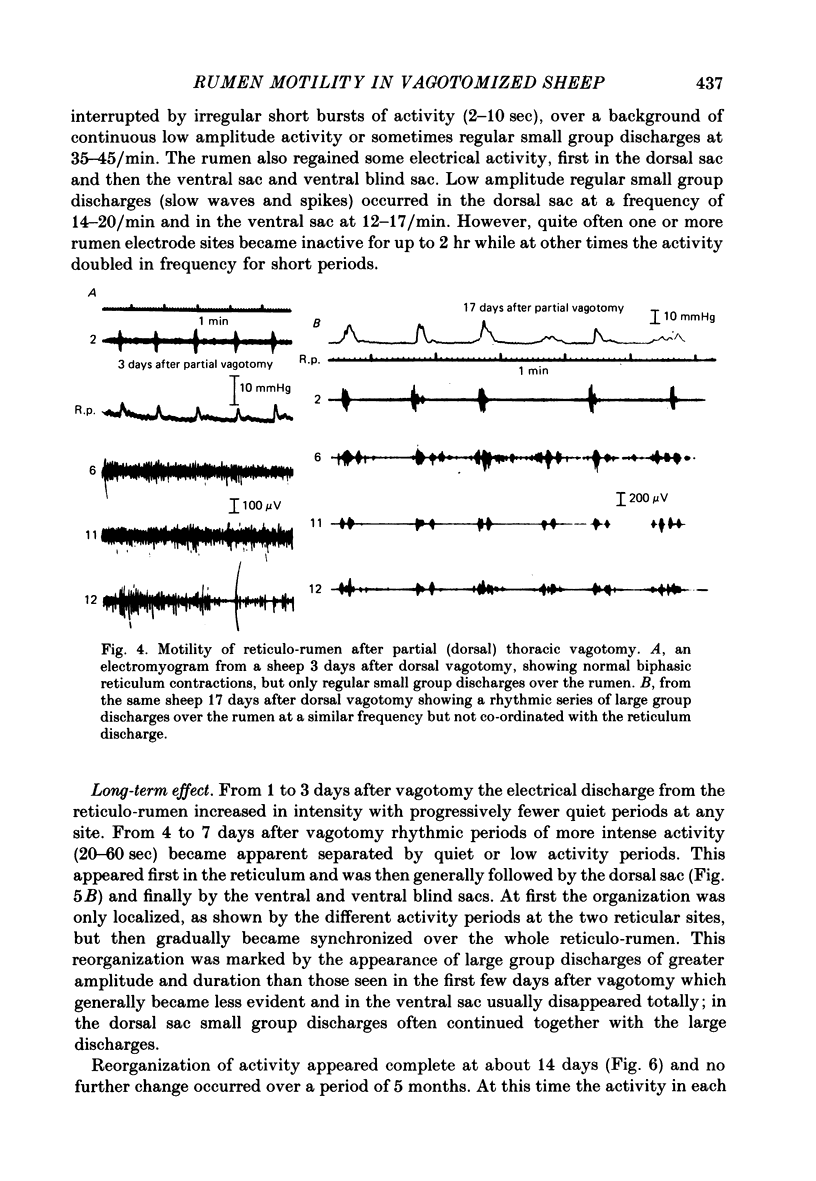


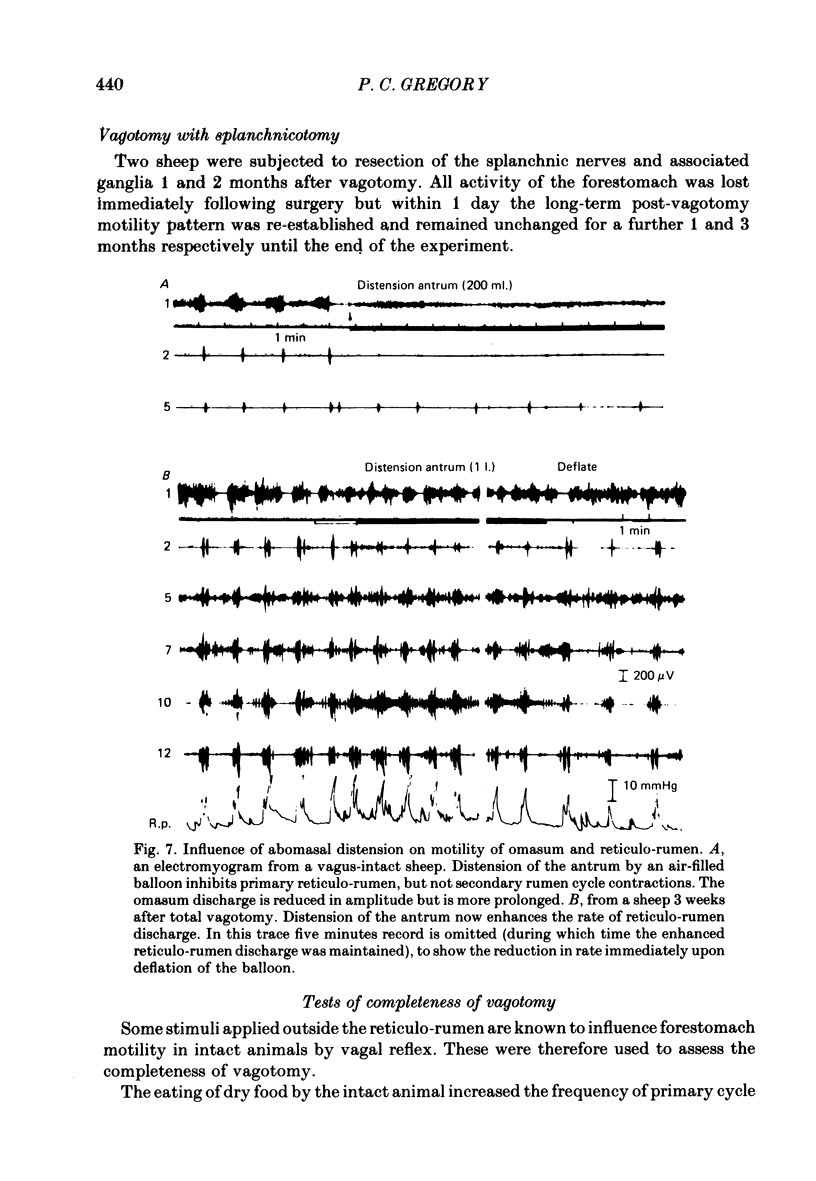

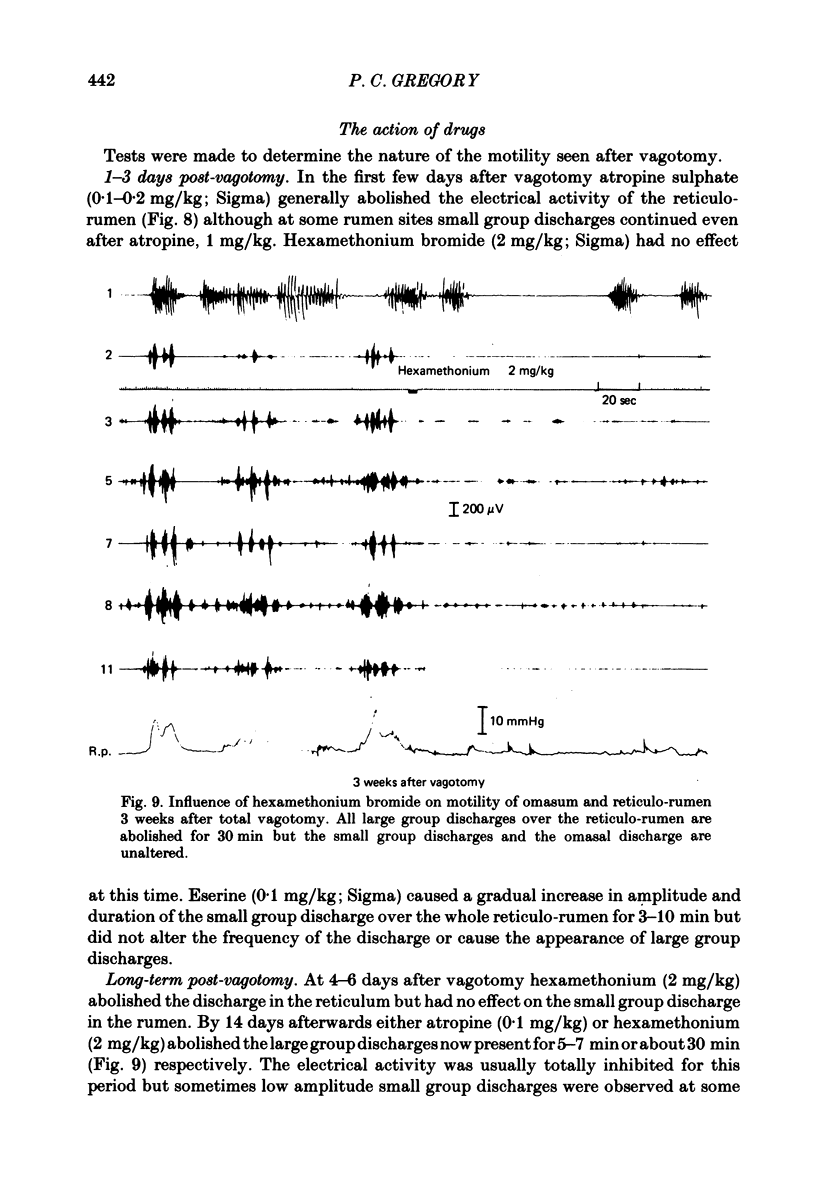

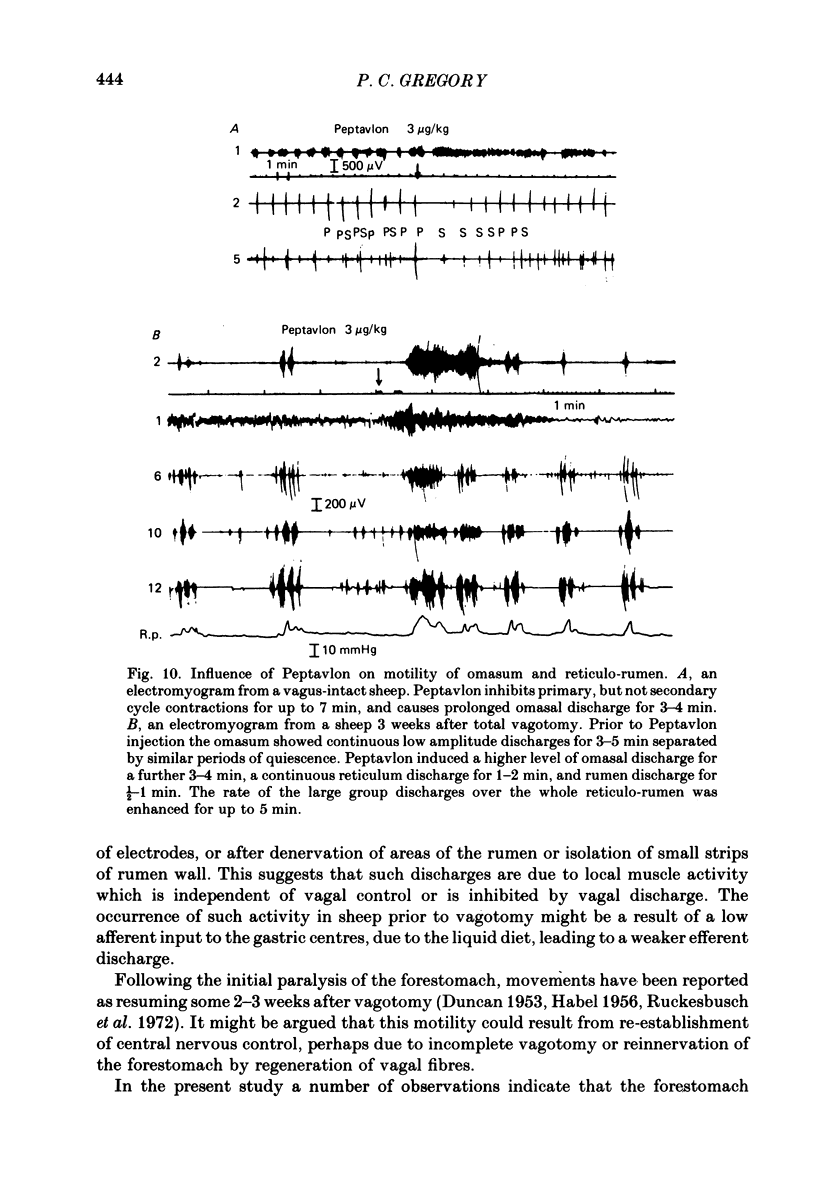

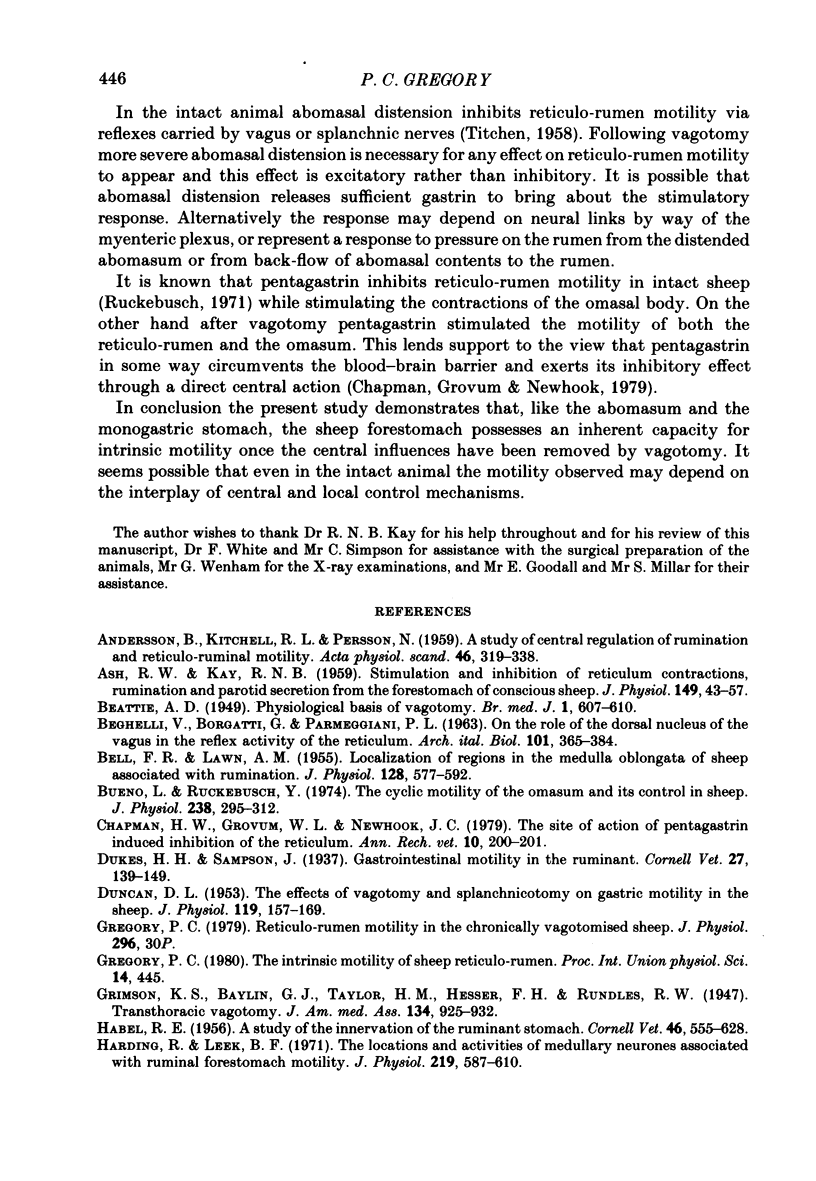

Selected References
These references are in PubMed. This may not be the complete list of references from this article.
- ANDERSSON B., KITCHELL R. L., PERSSON N. A study of central regulation of rumination and reticulo-ruminal motility. Acta Physiol Scand. 1959 Aug 31;46:319–338. doi: 10.1111/j.1748-1716.1959.tb01762.x. [DOI] [PubMed] [Google Scholar]
- ASH R. W., KAY R. N. Stimulation and inhibition of reticulum contractions, rumination and parotid secretion from the forestomach of conscious sheep. J Physiol. 1959 Dec;149:43–57. doi: 10.1113/jphysiol.1959.sp006324. [DOI] [PMC free article] [PubMed] [Google Scholar]
- BEATTIE A. D. The physiological bases of vagotomy. Br Med J. 1949 Apr 9;1(4605):607–610. doi: 10.1136/bmj.1.4605.607. [DOI] [PMC free article] [PubMed] [Google Scholar]
- BEGHELLI V., BORGATTI G., PARMEGGIANI P. L. ON THE ROLE OF THE DORSAL NUCLEUS OF THE VAGUS IN THE REFLEX ACTIVITY OF THE RETICULUM. Arch Ital Biol. 1963 Oct 5;101:365–384. [PubMed] [Google Scholar]
- BELL F. R., LAWN A. M. Localization of regions in the medulla oblongata of sheep associated with rumination. J Physiol. 1955 Jun 28;128(3):577–592. doi: 10.1113/jphysiol.1955.sp005326. [DOI] [PMC free article] [PubMed] [Google Scholar]
- Bueno L., Ruckebusch Y. The cyclic motility of the omasum and its control in sheep. J Physiol. 1974 Apr;238(2):295–312. doi: 10.1113/jphysiol.1974.sp010525. [DOI] [PMC free article] [PubMed] [Google Scholar]
- Chapman H. W., Grovum W. L., Newhook J. C. The site of action of pentagastrin-induced inhibition of the reticulum. Ann Rech Vet. 1979;10(2-3):200–201. [PubMed] [Google Scholar]
- DUNCAN D. L. The effects of vagotomy and splanchnotomy on gastric motility in the sheep. J Physiol. 1953 Feb 27;119(2-3):157–169. doi: 10.1113/jphysiol.1953.sp004836. [DOI] [PMC free article] [PubMed] [Google Scholar]
- Gregory P. C. Reticulo-rumen motility in the chronically vagotomized sheep [proceedings]. J Physiol. 1979 Nov;296:30P–30P. [PubMed] [Google Scholar]
- HABEL R. E. A study of the innervation of the ruminant stomach. Cornell Vet. 1956 Oct;46(4):555–633. [PubMed] [Google Scholar]
- Harding R., Leek B. F. The effects of peripheral and central nervous influences on gastric centre neuronal activity in sheep. J Physiol. 1972 Sep;225(2):309–338. doi: 10.1113/jphysiol.1972.sp009942. [DOI] [PMC free article] [PubMed] [Google Scholar]
- Harding R., Leek B. F. The locations and activities of medullary neurons associated with ruminant forestomach motility. J Physiol. 1971 Dec;219(3):587–610. doi: 10.1113/jphysiol.1971.sp009679. [DOI] [PMC free article] [PubMed] [Google Scholar]
- IGGO A. Central nervous control of gastric movements in sheep and goats. J Physiol. 1956 Jan 27;131(1):248–256. doi: 10.1113/jphysiol.1956.sp005460. [DOI] [PMC free article] [PubMed] [Google Scholar]
- Iggo A., Leek B. F. An electrophysiological study of some reticulo-ruminal and abomasal reflexes in sheep. J Physiol. 1967 Nov;193(1):95–119. doi: 10.1113/jphysiol.1967.sp008345. [DOI] [PMC free article] [PubMed] [Google Scholar]
- Leek B. F. Reticulo-ruminal function and dysfunction. Vet Rec. 1969 Mar 8;84(10):238–243. doi: 10.1136/vr.84.10.238. [DOI] [PubMed] [Google Scholar]
- Leek B. F. Reticulo-ruminal mechanoreceptors in sheep. J Physiol. 1969 Jun;202(3):585–609. doi: 10.1113/jphysiol.1969.sp008829. [DOI] [PMC free article] [PubMed] [Google Scholar]
- Newhook J. C., Titchen D. A. Effects of stimulation of efferent fibres of the vagus on the reticulo-omasal orifice of the sheep. J Physiol. 1972 Apr;222(2):407–418. doi: 10.1113/jphysiol.1972.sp009805. [DOI] [PMC free article] [PubMed] [Google Scholar]
- Orskov E. R., Grubb D. A., Wenham G., Corrigall W. The sustenance of growing and fattening ruminants by intragastric infusion of volatile fatty acid and protein. Br J Nutr. 1979 May;41(3):553–558. doi: 10.1079/bjn19790070. [DOI] [PubMed] [Google Scholar]
- Ruckebusch Y. The effects of pentagastrin on the motility of the ruminant stomach. Experientia. 1971 Oct 15;27(10):1185–1186. doi: 10.1007/BF02286916. [DOI] [PubMed] [Google Scholar]
- Ruckebusch Y. The electrical activity of the digestive tract of the sheep as an indication of the mechanical events in various regions. J Physiol. 1970 Nov;210(4):857–882. doi: 10.1113/jphysiol.1970.sp009246. [DOI] [PMC free article] [PubMed] [Google Scholar]
- Ruckebusch Y., Tsiamitas C., Bueno L. The intrinsic electrical activity of the ruminant stomach. Life Sci I. 1972 Jan 15;11(2):55–64. doi: 10.1016/0024-3205(72)90163-4. [DOI] [PubMed] [Google Scholar]
- TITCHEN D. A. Reflex stimulation and inhibition of reticulum contractions in the ruminant stomach. J Physiol. 1958 Apr 3;141(1):1–21. doi: 10.1113/jphysiol.1958.sp005950. [DOI] [PMC free article] [PubMed] [Google Scholar]


